We drove up into the mountains to Idaho Springs via the smaller, scenic highway.

The tunnels had such creative names as Tunnel 1 and Tunnel 6. This is Tunnel 3

Following the Clear Creek river
We made a quick stopped into the visitor center.


Original 1906 mining claims map
There are over 5,100 claims on this map. A typical claim measured 150 feet by 1,500 feet on the surface, with the mineral rights existing below. A miner had to begin digging within surface borders but could follow a vein underground even if it left the above-ground boundaries. Miners sometimes collided with each other when veins converged. Each claim was numbered as it was filed with the local authorities. The lower numbers go back to claims from 1859. As claims were mined out or abandoned, later claims might overlap them.
Many early miners discovered that selling existing claims to later arrivals was generally easier and more profitable than actual mining. In the case of Thomas Cooper, that didn't work out so well. He sold his share in the Lamartine Mine in 1888 for $25. The first shipment of ore that came from the mine was worth $25,000.

A model of a Five Stamp Mill

A tribute to the miner's best friend... the donkey. Suddenly I think the phrase "kiss your ass goodbye" could take on a whole new meaning down in the dangerous mines!

A model of the old train depot
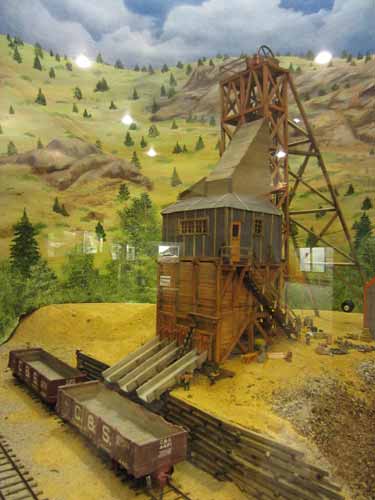
Loading the rail cars


An ore car

Some tight spaces!
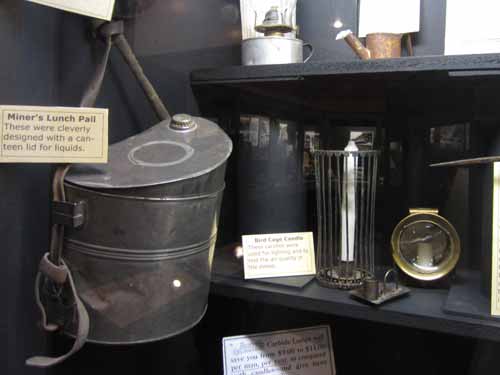
The lid of the lunch pail is actually a canteen.

Placer mining in 1859 - Miners shoveled dirt and rocks into wooden troughs with ribbed "riffles" made from old wagon parts. These riffles filtered the material, catching the denser gold and black sand.

An old Assay office - The fire assay is a method for estimating the gold and silver content of ores. The metals are smelted from an ore sample under intense heat.

The American double action 5-shot pistol used by the first town marshall
There was a section containing lots of 10th Mountain Division artifacts (we had already seen their memorial on Tennessee Pass on our way to Leadville). Apparently they were on loan from the Colorado Ski & Snowboard Museum in Vail.

The light cargo carrier
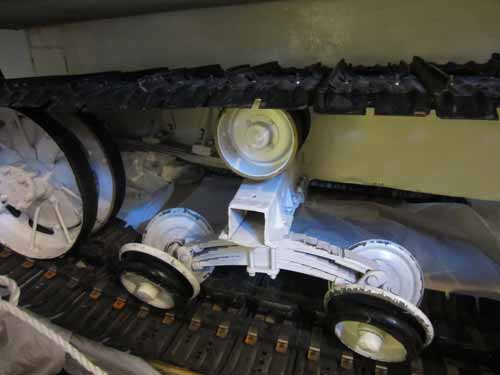

The clouds held back their moisture and we were able to wander around the charming downtown for a bit.





On the Colorado flag, the blue is meant to represent the skies, the gold is either sunshine or gold, the white is the snowcapped peaks, and the red is for the color of the dirt (from Spanish colorado, meaning 'ruddy' or 'colored'). It was designed in 1911.

The Grass Valley School House was built in 1901. The design is typical of schools built at that time. The school bell was also used as a fire alarm. It was closed in 1917 and turned into apartments. It was moved to this spot in 1986 and is now the city hall.

The railroad came to Idaho Springs in 1877. It closed to passenger service in 1927 and finally abandoned in 1941.

The Engine No. 60 (originally No. 263 before it changed lines and companies) was built in 1886 and served for 64 years. It never had a wreck or anyone injured on it.



Coach No. 70 (originally No. 168) was built in 1896 by the St. Charles Coach Company. It the last remaining passenger coach of its style in existence.
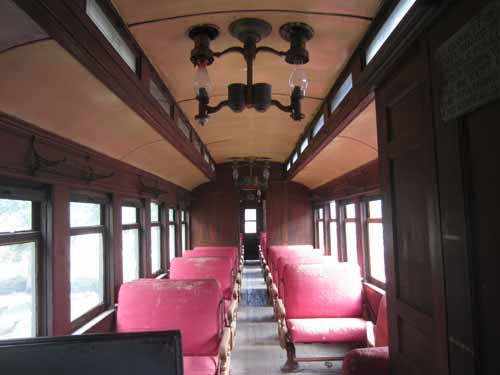
We crossed the bridge to see the old waterwheel.

Charlie Tayler used this waterwheel, built in 1893, to power a stamp mill on Ute Creek. He attributed his good health to the fact that he never kissed women or took baths. He was also known to have dined on chipmunk stew. The waterwheel was moved to this location in 1946 and restored in 1988.
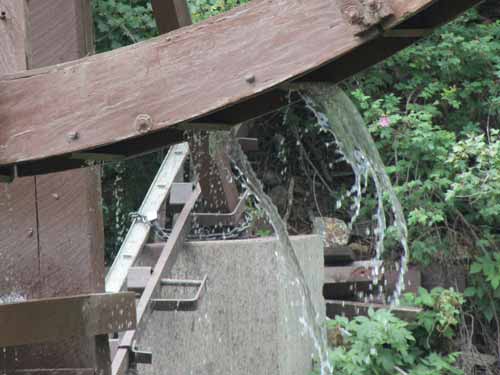

Some rafters race by...

... clearly having a wonderful time!
We decided to have lunch in a restaurant named Beaujo's.

A giant local Tommyknocker's Maple Nut Brown ale, served in a jar

Our enormous, delicious meals

Honey is always served, in order to dip the thick crust in.

The brewery that made our beer. A Tommyknocker (which goes by many other names in different countries... such as Bwca, knockers or brownies) is a mythical creature equivalent to the leprechaun. They are around two feet tall, live underground, and commit random mischief such as stealing miners' tools and food. Their name comes from the knocking sound that happens just before a cave-in – actually the creaking of earth and timbers before giving way. To some of the miners, they were evil and the sound is of them hammering at the supports to cause the cave-in. To others, the knocking was a way of warning the miners. According to some folklore, they were the helpful spirits of people who had died in previous accidents. In the 1820s, immigrant Welsh miners brought tales of the knockers to western Pennsylvania. The 1848 gold rush brought the miners (and their stories) to California.
We were going to head out when we noticed the free Underhill Museum across the street. So we popped in. The friendly woman inside told us some information on the place and then let us wander about.
Dr. James Underhill came to Idaho Springs in 1897 and was a prominent surveyor and mining engineer. He was also the first person in Colorado to earn his doctorate in geology. He and his wife, Lucy, built the place as a combination home and office with two front entrances, one for business and the other for personal visits. James lived in this building until his death in 1954 at the age of 83. Lucy remained until 1963, when she gave the building to the city for use as a museum. It was her desire that it never become a tavern.



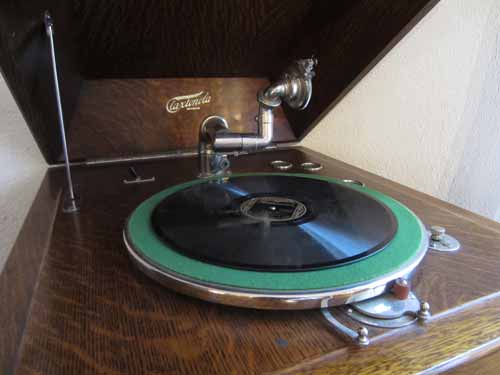
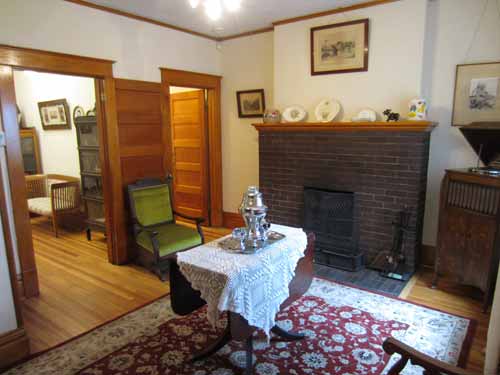

The second entrance

Made by the Great Western Stove Company in Denver (in business from around 1875 - 1920's), this is a Wonder wood-burning stove.

A 'family sized' washboard

The fridge
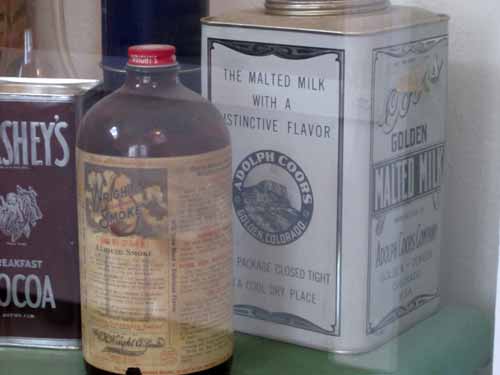
It's the Adolph Coors malted milk!

An upstairs bedroom. I love the old travel trunks!
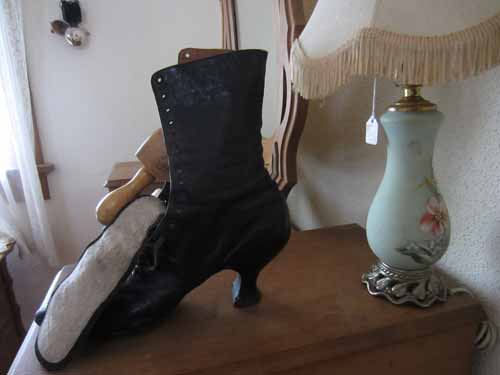
Items from the past


Both the closet and the dresser are built into the walls.

Lucy was a avid gardener. Guests are still entertained in this courtyard to this day.

The town around 1880...

... and then around 1890.


Ummm... the guy in the upper right is smoking a cigarette... inside a mine?!

